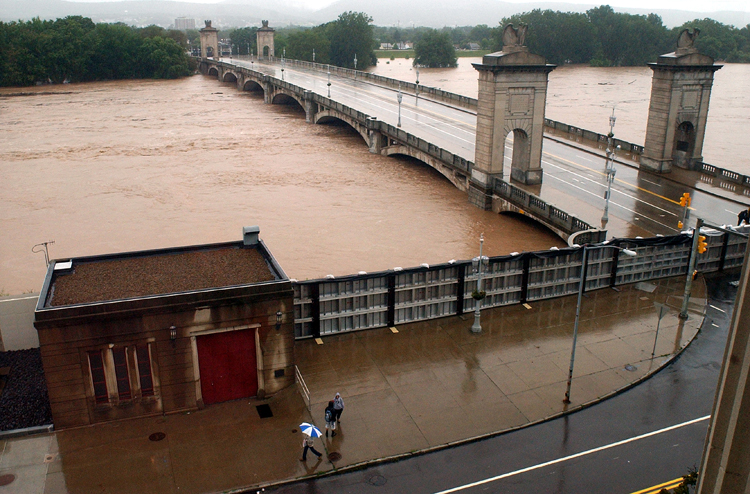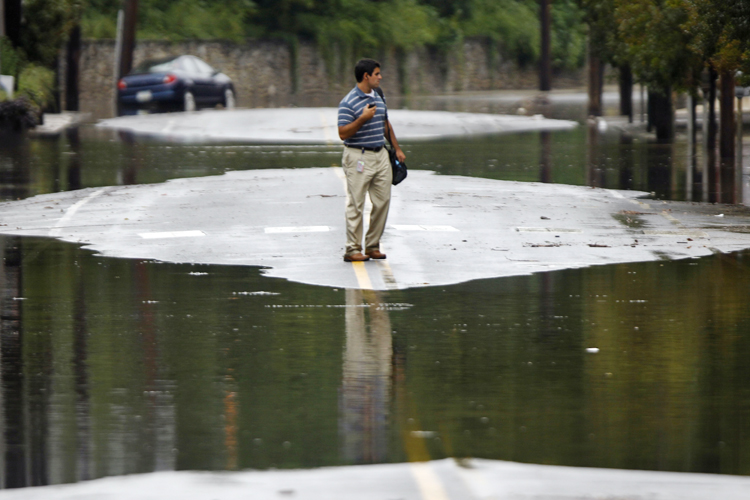WILKES-BARRE, Pa. — Nearly 100,000 people from New York to Maryland were ordered to flee the rising Susquehanna River today as the remnants of Tropical Storm Lee dumped more rain across the Northeast, closing major highways and socking areas still recovering from Hurricane Irene.
At Binghamton, N.Y., the wide river broke a flood record and flowed over retaining walls downtown as more than 8 inches of rain fell in some areas. Road closures effectively sealed the city off to outside traffic as emergency responders scrambled to evacuate holdouts who didn’t heed warnings to leave neighborhoods.
“It’s going to get worse,” said Gov. Andrew Cuomo, who urged residents to heed evacuate orders rather than wait until the flood danger is obvious.
“By the time it looks that bad, you won’t be able to leave, so leave and leave now,” he said.
Most of the people ordered to evacuate their homes were about 80 miles downstream in Wilkes-Barre, where the river was projected to crest later today at 41 feet — the same height as the levee system, officials said. Residents were ordered to leave by 4 p.m.
In Port Deposit, Md., rising water levels at the Conowingo Dam forced officials to open the floodgates and order the evacuation of most of the Susquehanna River town’s 1,000 residents.
There was also flooding upstream from Binghamton in Oneonta, N.Y., where dozens of evacuees sought help at a church center.
“By seven o’clock (this morning), we got a knock on our door saying we had to leave,” said Kevin Olmstead, a cab driver who had to leave with his fiancee, 10-year-old daughter and other relatives so quickly that he only had clothes, cell phone and an iPad. “We actually had to tread through the water to get out.”
Roads and highways closed around the region, including sections of New York’s Interstate 88, which follows the Susquehanna’s path. In Philadelphia, flooding and a rock slide closed the eastbound lanes of the Schuylkill Expressway, a major artery into the city, and it could take hours for the road to reopen.
New York’s Thruway Authority expected to close a 105-mile stretch of its busiest east-west highway, Interstate 90, because the nearby Mohawk River had overflowed its banks in some areas.
Wet weather followed by Hurricane Irene and its remnants have saturated the soil across the Northeast, leaving water no place to go but into already swollen creeks and rivers.
After three days of living in shelters because of Irene, Edith Rodriguez, her mother and her sister spent Wednesday night at a high school outside Schenectady when the latest storm chased them from their home near the Mohawk River.
“We just finished cleaning up after the flood from Irene,” the 19-year-old said. “Now we have to start all over again.”
Many areas flooding this week had been spared a direct hit by Irene, but authorities took no chances in the same places inundated by historic flooding after Hurricane Agnes in 1972.
The National Weather Service predicted 4 to 10 inches of rain across the mid-Atlantic and Northeast through today. Flood watches and warnings were in effect from Maryland to New England.
The service said the river level in Binghamton is above 25 feet, higher than the record set in 2006 and more than 11 feet above flood stage. It’s expected to rise another foot or so.
Evacuation orders were issued Wednesday to some 20,000 people in Binghamton and neighboring communities along the Susquehanna. More than 70,000 residents in Wilkes-Barre and Kingston were told to leave. So were people in about 170 homes about 90 miles downstream in Harrisburg, where crews put sandbags around the governor’s mansion.
Wilkes-Barre Mayor Tom Leighton said residents should prepare for an evacuation of 72 hours and advised them to take clothing, food and prescription medicine. He also asked city businesses to close their doors by noon.
The evacuations come as the remnants of Lee, which has caused flooding and power outages across the South since hitting the Gulf Coast last week, slogged northward. At least nine deaths have been blamed on Lee and its aftermath.
In New Jersey, where many residents were still cleaning up after Irene, the remnants of Lee were expected to drop anywhere from 2 to 5 inches of rain. There was some flooding along rivers including the Passaic, which breached its banks during Irene and caused serious damage. Heavier flooding is expected today.
Flash flooding shut down roads and closed schools in many parts of Pennsylvania. A bridge spanning the Delaware River between New Hope, Pa., and Lambertville, N.J., closed this morning as flood waters carried debris downriver.
A flood watch was in effect through this afternoon in soggy Vermont but officials today said that rain has caused only minor problems in the state. Parts of the state are still recovering from flooding from the remnants of Irene, which was a tropical storm by the time it swept over the area.
Send questions/comments to the editors.






Success. Please wait for the page to reload. If the page does not reload within 5 seconds, please refresh the page.
Enter your email and password to access comments.
Hi, to comment on stories you must . This profile is in addition to your subscription and website login.
Already have a commenting profile? .
Invalid username/password.
Please check your email to confirm and complete your registration.
Only subscribers are eligible to post comments. Please subscribe or login first for digital access. Here’s why.
Use the form below to reset your password. When you've submitted your account email, we will send an email with a reset code.